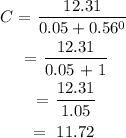ANSWER:
a) 12 cats
b) 232
c) 246
d) 14
Step-by-step explanation:
Given the expression for number of cats C present at time t:

a) To find the number of cats initially on the reserve, let t = 0
Therefore, substitute 0 for t in the equation

Number of cats initially on the reserve are approximately 12 cats
b) C(10):

C(10) = 232
Here, C(10) means that C is a function of 10. This means at time = 10 years
C)Using function notation to express the number of cats present after 17 years, we have:


Therefore, number of cats present after 17 years are approximately 246 cats
C(17) = 246 cats
d) In this case, first find the number of cats present in the 10th year and subtract from the number of cats present in the 17th year.

From question C above, we know C(17) = 246
Therefore, the increase in cat population to be expected from the 10th year to the 17th year is:
C(17) - C(10) = 246 - 232 = 14 cats